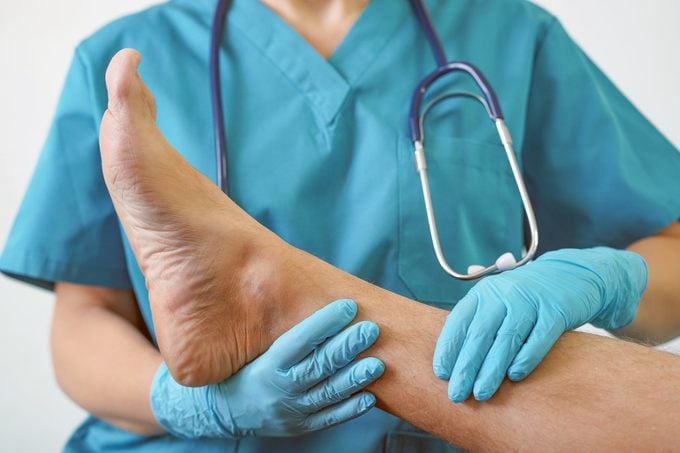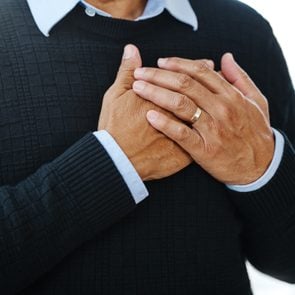Why Does Heart Failure Cause Swollen Feet?
Updated: May 20, 2021
The heart and feet are nowhere near each other, so what is the connection between heart failure and swollen feet? Our heart experts explain.
What is heart failure?
Heart failure is a chronic condition affecting about 6.2 million Americans. It occurs when the heart muscle is damaged—sometimes from something you can’t control, like an injury, virus, or congenital heart disease—and struggles to pump enough blood to meet the body’s needs.
However, heart failure can also result from conditions or lifestyles you might have some command over, such as high blood pressure, diabetes, coronary heart disease, untreated sleep apnea, obesity, or use of drugs and alcohol.
There are four stages of heart failure, and in the later stages, the heart weakens, gets larger, and can’t pump enough oxygen-rich blood to supply the body’s needs. When symptoms grow worse (more on this later), heart failure can cause swelling in the ankles and legs, as well as swollen feet.
This is due to edema, which is a fluid accumulation in the body—usually in the limbs and lungs—that often occurs as a result of heart failure.
Here’s what you need to know about what causes swollen feet, how to treat it, and what it could mean for your heart failure.
Symptoms of heart failure
In the early stages of heart failure, people might not experience any symptoms. But as heart failure progresses, symptoms may occur one by one or all together—and yes, swollen feet is one of them.
- Shortness of breath while doing simple, everyday activities like climbing the stairs or walking to the mailbox
- Trouble breathing while reclining in a chair or lying down at night
- Waking up and catching your breath
- Tiring easily
- Frequent coughing
- Dry, hacking cough while lying down
- Coughing that produces a pink or blood-tinged mucus
- Swollen legs, feet, and ankles
- Swollen abdomen
- More frequent urination at night
- Lack of appetite and nausea
- Fatigue
- Feet and hands feel colder than other parts of the body
- Problems concentrating

What causes swollen feet?
An edema-related swelling or a bloated feeling occurs when excess fluid gets trapped in the body’s tissues. Although edema can happen with heart failure, it can also occur with kidney disease, cirrhosis of the liver, pregnancy, or due to medications.
If you’ve ever felt bloated after eating a meal high in salt or you’ve had swollen feet after standing all day or sitting on a long flight, you’ve experienced edema. This kind of edema is short-lived and resolves on its own. Edema in heart failure occurs when the heart isn’t pushing blood out of the heart efficiently. That leads to more blood left behind in the heart after each beat, leading to difficulty getting blood into the heart.
“The backup of blood waiting to get into the heart leads to increasing pressure in the veins draining into the heart,” says Lee Goldberg, MD, a cardiologist and section chief, Advanced Heart Failure and Cardiac Transplant at the University of Pennsylvania, in Philadelphia.
“As the pressure in the veins increases, fluid is pushed out into the tissues leading to swelling or edema,” says Dr. Goldberg, who is also a professor of cardiovascular medicine in the Perelman School of Medicine at the University of Pennsylvania.
The kidney’s role in edema
When the heart starts to fail, the blood flow to the kidneys decreases. When this happens, it may prompt the kidneys to hold on to sodium and water, leading to edema.
“The kidneys attempt to maintain a normal state when they sense the decrease in blood flow,” says Columbus Batiste, MD, an interventional cardiologist at Kaiser Permanente in Riverside, California. “As a result of attempting to maintain a normal fluid state (or blood volume), the kidneys trigger a cascade of chemical messengers in the form of the hormones renin, aldosterone, and vasopressin, which ultimately leads to increased sodium, water retention, and thirst.”
Edema in other parts of the body
When the right side of your heart—which receives oxygen-poor blood from the body and sends it to the lungs—isn’t pumping effectively, blood tends to pool in the lower legs, ankles, and feet. Yet, it can occur in other areas.
“One of the largest veins in the body is the inferior vena cava that connects directly to the liver,” says Dr. Goldberg. “As the venous pressures increase, fluid can be pushed out of the liver and into the abdominal cavity leading to abdominal edema.”
Edema can also show up in the hands, back, and face. And when the left side of the heart—which receives oxygen-rich blood from the lungs and then pumps it to the rest of the body—isn’t doing its job, fluid can accumulate in the lungs, in a condition known as pulmonary edema.
Symptoms of edema
Besides the swelling or bloated feeling, edema may cause the skin to look shiny or stretched. Another sure sign of edema is “pitting.” A term used to describe a dimple that remains after the skin is pressed with a finger for several seconds.
Edema is present if the dimple doesn’t bounce back and a dimple remains on the skin.
How to monitor edema
Untreated edema makes your heart work harder than it needs to. Heart failure patients should be on the lookout for edema daily by monitoring their overall amount of fluid and recording their weight daily. Dr. Goldberg says this should be done at the same time every day, wearing the same type of clothing, using the same weight scale.
“Sudden increases in weight may indicate increased fluid retention,” says Dr. Goldberg. People may also use a tape measure to measure the legs or abdomen’s circumference or the pitting test. If you gain two to three pounds overnight or three to five pounds in one week, check in with your doctor.
When to call the doctor
Call your doctor if you notice redness, skin breakdown or wounds, weeping of fluid, inability to walk, fever, pain, increased shortness of breath, or chest pain.
Note that new edema, especially if it occurs on one side, should also prompt an evaluation, Dr. Goldberg says, as that might be a sign of a life-threatening blood clot.
Treatments for edema
“The best way to treat edema due to heart failure is to manage the heart failure,” Dr. Goldberg says. That encompasses sticking with healthy lifestyle habits, such as exercising daily, quitting smoking, limiting alcohol, and eating heart-healthy foods, as well as taking your heart failure (and non-heart-related) medications as prescribed.
Diuretics (water pills) are the most common medication to treat edema directly. They help remove sodium and fluid from the body.
Note: Over-the-counter or herbal supplements that are labeled as water pills are not acceptable for edema.
Budget salt intake
As Dr. Goldberg mentioned, limiting salt minimizes edema. Another good reason to avoid salt— too much of it puts wear and tear on the blood vessel walls, forcing the heart to work harder. Unless your doctor recommends otherwise, heart failure patients should consume no more than 2,000 milligrams (mg) of sodium daily, and ideally no more than 1,500 mg a day, according to the American Heart Association. The Dietary Guidelines for Americans is 2,300 milligrams or less per day.
Jenifer Bowman, RD, a registered dietitian at UCHealth in Fort Collins, Colorado, advises her heart failure patients to look at salt intake like a daily budget. “I tell my patients they have 2,000 mg of sodium to spend on their foods and beverages every day, but avoid going over budget,” she says.
She also advises patients to keep a food log to help track their salt and become familiar with the salt content of common foods.
Watch fluid intake
Generally, later-stage heart failure patients are advised to limit fluids to two liters per day because processing more fluids puts undue stress and extra work on the heart. But fluids fall into other categories besides water and other beverages. Patients must also consider water-rich foods such as jello, ice chips, fruits, and veggies.
“Fruits and vegetables contain moisture and can add to our overall hydration,” says Bowman. “General recommendations encourage two cups of fruit and three cups of vegetables daily. And your heart will thank you for choosing healthy beverages first.”
Bowman encourages her patients to choose “beverages that provide good hydration,” she says. “At least half of their daily fluids should be water. The other half can include other beverages such as coffee, tea, milk, and juice.”
Compression socks
Compression socks have come a long way from their ugly, drab nude color. Today, they are available in a rainbow of colors and designs. Of course, their best feature is that they help with circulation, reduce the appearance and pain of varicose veins, and in the early stages of heart failure, can improve edema.
“Their use has not been well studied in heart failure,” says cardiologist Tamara Horwich, MD, associate clinical professor of medicine and cardiology at the David Geffen School of Medicine. Dr. Horwich says they are generally safe to wear in the early stages of heart failure. But they should be avoided in later stages (i.e., the New York Heart Association class III and IV) of heart failure due to lack of data and potential harm.
Compression socks come in different grades and varieties. Dr. Horwich advises socks that cover the entire foot and leg up to the knee, beginning with grade one. Generally, most people can put them on first thing in the morning and wear them until they go to bed. But you may be able to wear them during sleep.
Ask your doctor for the grade you should get and wearing instructions before buying a pair. If you don’t wear compression socks, avoid standing or sitting for extended periods, and elevate your feet throughout the day as much as possible.
(Here are the best compression socks that come expert-recommended.)
Pneumatic compression mechanical device
Imagine a blood pressure cuff worn on the body that intermittently inflates, compresses, and deflates through various cycles. That’s the idea behind a pneumatic compression device.
They’re typically sold as boots you slip into or as a large wrap that goes around your lower leg and fastens with velcro. They massage your legs, and a small study published in 2014 in Lympathic Research and Biology suggested that edema decreased or didn’t get worse after using a pneumatic compression device for three years.
“There have been some very small studies showing their safety in heart failure,” says Dr. Horwich. “But most physicians would say that more studies are needed to better clarify their use in heart failure patients.” It may be worth a try, if not for edema then for achy legs. Just check with your doctor first.



